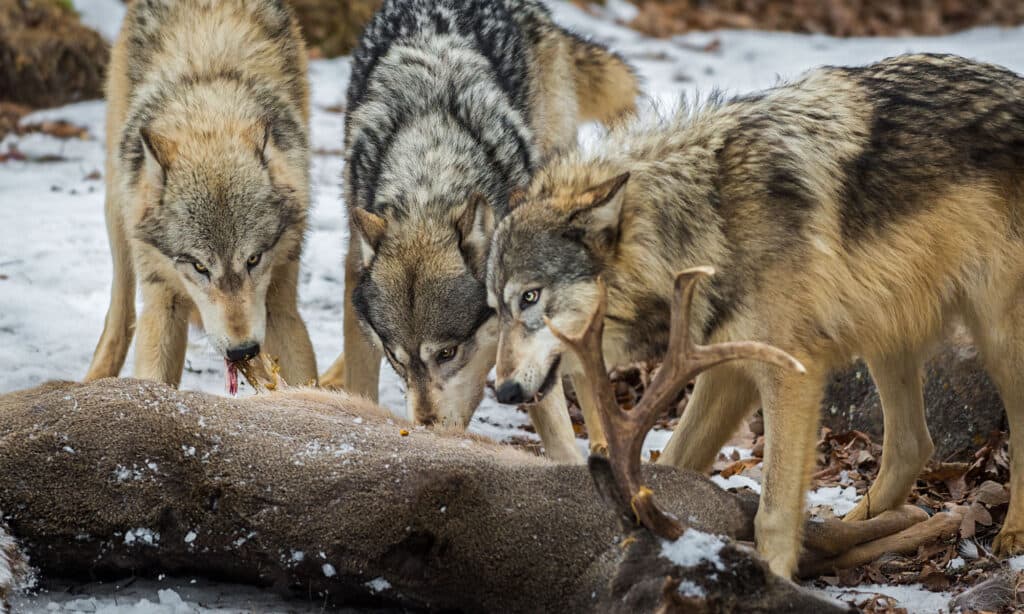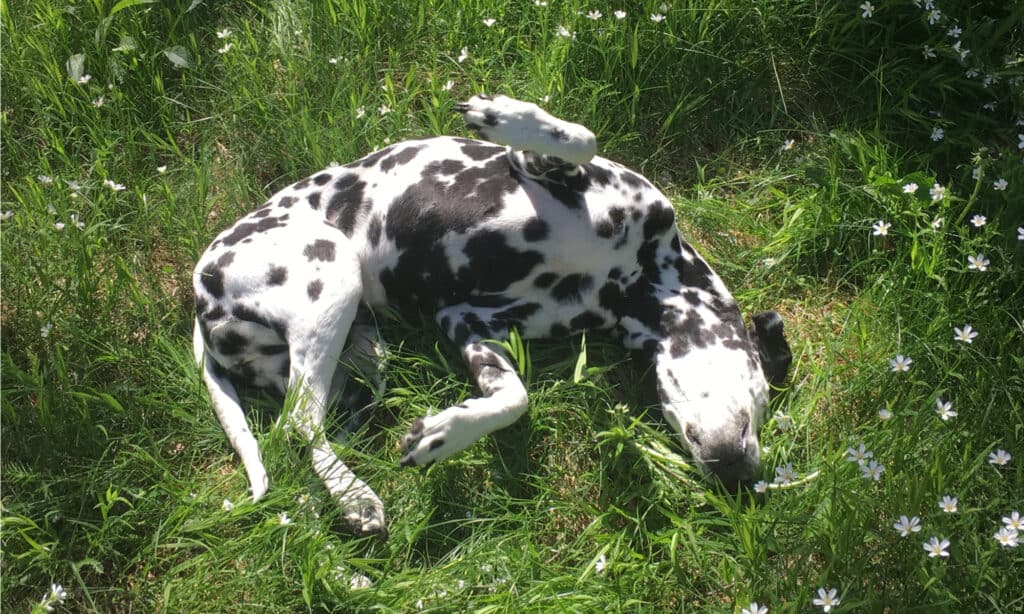Wolves communicate via sounds, scents, and body language. Wolf language is hugely important because wolves live in packs that cooperate and live or die based on their interactions. For example, a successful hunt relies upon clear pack communication, and language reinforces pack structure so each member understands their role. But how do wolves communicate? What techniques enable wolves to speak?
1. Sound

Wolves don’t howl at the moon, it’s just a co-incidence.
©Alexander Sviridov/Shutterstock.com
Sound is highly important in wolf communication.
The most common sound we associate with wolves is a spine-chilling howl. Howling from one wolf often turns into a pack activity preceding a hunt or mourning a loss. Groups howls generate a good deal of excitement that often leads to arguments and disagreements. Even cubs join in the pack chorus, producing adorable “ah-woos.”
Howls are designed to carry long distances, and after the howl has finished, wolves stop to listen for a response. A lone wolf will howl, potentially to find company or find its way back to a lost pack. Experts believe howling also establishes territory. Wolf packs travel depending on the season and available food, so long-distance howls are thought to establish their new patch.
The idea of wolves howling at the moon is well-established, but it’s not true; it’s just a coincidence! When a wolf howls, it throws back its head so its snout points skyward, and because they’re often active at night, it appears they’re howling at the moon. The moon is more visible on clear nights, too, when sounds travel further, and humans are more likely to hear them.
But howls are not the only sound wolves make to communicate. They also make the following noises to pack members:
Barks: Wolves rarely bark, but if one does so, it’s to communicate danger.
Whimpers: Friendly whines and whimpers indicate calmness and attention seeking, but they can also mean anxiety or stress.
Growls: A growl is a threat. Soft as a warning to back off, through to full-on growling and snarling before a physical disagreement.
Yips: Playful yips and squeaks indicate fun. Yips and yaps occur during play, such as chases or wrestling.
Sound is especially important during a pack hunt. To ensure a successful hunt, wolf members spread out and use various long, short, high, and low howls to communicate their position. First, the swiftest wolves chase and harass prey until it falters, then sturdy adults bring it down.
2. Body Language

Wolf’s facial expressions communicate dominance and create pack order.
©Holly Kuchera/Shutterstock.com
Wolf’s body language communicates a great deal, even though it’s silent. Wolves use body positions, movements, and facial expressions to speak.
Positions
High-ranking wolves stand erect and proud with high heads and shoulders. Lower-ranking wolves communicate their submission and their lowly pack position by crouching, cringing, and rolling over to expose their soft underbelly to the more dominant wolves. Crouching lower-ranking wolves may lick the dominant wolf’s muzzle like a puppy.
A highly held head communicates dominance, but the wolf’s tail position is also an important signaling mechanism. An alpha wolf holds their tail high in the air like a flag to indicate their superiority to the pack, whereas lower-ranking wolves lower their tails. The lowest-ranking wolf hides its tail between its legs and under its body. Our pet dogs may do the same after naughty behavior.
Movement
Standing stock still with a fixed stare communicates a warning to others, such as approaching danger or that they’re unimpressed with certain behaviors. A stock still wolf also indicates it’s spotted prey.
But wolf communication isn’t all about dominance; a wolf enjoys its pack environment, too. For example, bowing is something we see our pet dogs do. It’s an invitation to play, and their wolf ancestors do the same.
If a wolf wants to play, it will outstretch its front paws and lower its head to the ground whilst its rear pokes up. Playful wolves also wag their tails, have zoomies, and enjoy chase games. Jaw-sparing is another form of wolf communication. This is a playful spar, often between youngsters standing on hind legs, to assert playful dominance in a relaxed group setting.
Facial Expressions
Wolf’s facial expressions range from half-closed sleepy eyes to curled lips, flat ears, and snarling.
A wolf may briefly show teeth as a warning before a full snarl with drawn-back lips that display terrifying teeth. A fully snarling wolf will also have side-flattened ears. Baring teeth is a dominant communication form in the pack and a reminder of authority.
A high-ranking wolf may also employ a fixed stare to tell another wolf their behavior isn’t welcome. A lesser-ranking wolf will look away from a dominant wolf’s fixed stare. If they don’t, or not quickly enough, it’ll lead to snarling.
A low-ranking wolf’s facial expressions are not as violent. When faced with a dominant wolf, it will flatten its ears, partially close its eyes, and crouch to communicate submissiveness.
3. Scent

Wolf tracks leave pheromone scents behind to communicate with others.
©Dennis W Donohue/Shutterstock.com
Like much of the animal world, wolves communicate through scent. A wolf’s acute sense of smell is 100,000 times stronger than a human’s. Wolves can catch scents over a mile away.
Here’s how wolves use scent to communicate:
Scats and Urine
Scats (that’s poop) and urine markings are strong communication signals to rival wolf packs. A wolf pack will leave urine scent marks and scats on territory edges to alert other packs to their presence and lay claim to the territory.
Experts think every wolf has different urine and scat scents, so pack members can identify who made the markings.
Pheromones
Each wolf has personal perfume! Their personal scent is developed in their scent glands, and pack members instantly recognize their pheromones, even after a long absence. Wolves emit scent through their tail and the glands in their feet. This enables a pack to follow members without catching sight of them.
Does your pooch roll in really stinky stuff? Wolves do, too! A wolf rolls on strongly scented objects, like rotting carcasses or feces, to bring that scent back to the pack. It’s a form of communication – look what I found! Next time your dog rolls in something unmentionable, put it down to their wolf pack heritage.

Pet dogs roll in super stinky stuff, just like wolves who communicate the scent to their pack.
©Elisa Day/Shutterstock.com
The photo featured at the top of this post is © slowmotiongli/Shutterstock.com
Thank you for reading! Have some feedback for us? Contact the AZ Animals editorial team.







